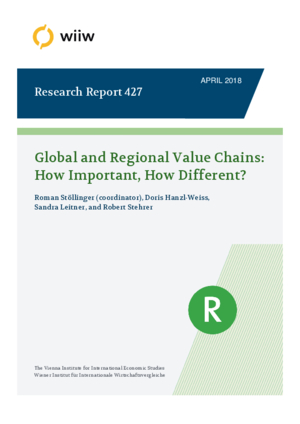Global and Regional Value Chains: How Important, How Different?
Doris Hanzl-Weiss, Sandra M. Leitner, Robert Stehrer and Roman Stöllinger
wiiw Research Report No. 427, April 2018
97 pages including 21 Tables and 22 Figures
This study investigates in detail value chain trade of the EU and its Member States, compares it to that of other trading blocs and regions such as NAFTA and East Asia, and delves into implications of value chain trade on specialisation and competitiveness as well as on the declining income elasticity of trade. The analysis of value chain (VC) trade, understood as trade that involves internationally organised production processes, is based on the latest update of the World Input-Output Database (WIOD). It relies to a large extent on a forward production integration measure termed re-exported domestic value added (DVAre) which comprises exports of intermediates that cross international borders at least twice. Results confirm the conjecture that the expansion of international value chains has come to a halt in the post-crisis period (2011-2014). Still, the EU’s VC trade was growing at the same pace as value added exports in general in the post-crisis years, implying that value chains were not dismantled. In contrast, worldwide VC trade was indeed less dynamic than value added exports, which could be seen as a sign that some value chains are on the retreat. Zooming closer into the EU, there was a marked reshuffling of market shares of Member States in EU-wide VC trade from large Member States such as France, Italy and the United Kingdom towards a group of Central European (CE) economies – Germany, Austria, the Czech Republic, Hungary, Poland and Slovakia – which together form the Central European Manufacturing Core. Looking at the question whether VC trade is rather regional in scope, VC trade is separated into regional value chain (RVC) trade – involving only regional production partners – and global value chain (GVC) trade – involving also extra-regional partner countries. For the EU as a whole this split is about half-half, with only a slight move towards GVC trade between 2000 and 2014. Strikingly, demand is strongly shaping the organisation of production: while RVCs are predominantly producing for the EU market, GVCs are predominantly procuring for third countries. As regards implications of value chain trade, these are harder to assess. Overall, implications for structural change and competitiveness are rather country and context specific. Changes in attitudes towards international value chains contributed to the significant decline in the income elasticity of trade.
Keywords: value chain trade, global value chains, regional value chains, Factory Europe, Factory North America, Factory Asia, revealed export preferences, regional introversion index, specialisation, competitiveness, income elasticity of trade
JEL classification: F14, F15
Countries covered: EU28, Asia-5, NAFTA
Research Areas: International Trade, Competitiveness and FDI
